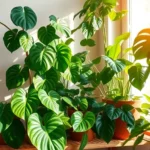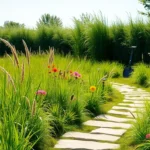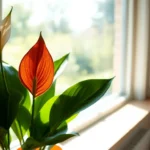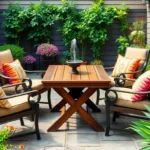Dahlias transform ordinary gardens into breathtaking displays of color and texture. These stunning blooms come in countless varieties – from dinner plate-sized giants to delicate pompons – making them perfect for creating dramatic focal points or charming border accents. Whether you’re a seasoned gardener or just starting your green thumb journey, we’ll show you how to design a dahlia garden that’ll be the envy of your neighborhood.
Planning your dahlia garden doesn’t have to be overwhelming. We’ve discovered that the key lies in understanding which varieties work best together and how to arrange them for maximum visual impact. From creating stunning color combinations to designing functional layouts that make maintenance a breeze, there’s a dahlia garden style that’ll perfectly match your space and skill level.
Ready to transform your outdoor space into a dahlia paradise? Let’s jump into the most inspiring and practical dahlia garden ideas that’ll help you create a show-stopping display from spring through fall.
Create a Stunning Dahlia Border Garden
Border gardens showcase dahlias beautifully while providing structure and visual impact to your industry. We’ll explore how strategic planning transforms ordinary flower beds into magnificent dahlia displays.
Choose Complementary Height Varieties
Tall dahlias work best as backdrop plants in border arrangements. Varieties like Cafe au Lait and Bishop of Llandaff reach 4-6 feet, creating dramatic vertical elements. Position these giants at the back of your border where they won’t overshadow smaller companions.
Medium height varieties fill the middle ground perfectly. Dahlias reaching 2-3 feet tall, such as David Howard or Labyrinth series, provide excellent transition between tall backdrop plants and front border specimens. These varieties bloom prolifically and maintain compact shapes throughout the growing season.
Compact dahlias shine as front border stars. Gallery series and other dwarf varieties stay under 18 inches, making them ideal edge plants. Their continuous blooms create colorful ribbons along walkways and garden borders.
Plan for Seasonal Color Progression
Early season blooms start your color show in mid-summer. We recommend planting early varieties like Bishop series or Mystic series for consistent color from July onward. These varieties establish quickly and provide foundation colors for your border design.
Peak season displays occur in late summer when most dahlia varieties reach full bloom potential. August through September brings the most dramatic color combinations. Plan your color palette around this peak period, choosing varieties that complement rather than compete with each other.
Late season performers extend your border’s beauty into fall. Varieties like Thomas Edison and Cafe au Lait continue blooming until first frost. These reliable performers ensure your border maintains visual interest when other garden areas start declining.
Incorporate Structural Plants as Backdrop
Evergreen shrubs provide year-round structure behind dahlia borders. Boxwood, yew, or juniper create solid green backdrops that make dahlia colors pop. These permanent plantings also provide wind protection for tall dahlia stems.
Ornamental grasses add texture and movement to dahlia borders. Fountain grass, miscanthus, or feather reed grass planted behind dahlias create beautiful contrast. Their neutral tones won’t compete with dahlia blooms while adding visual interest during dormant seasons.
Climbing plants on trellises or fences make excellent vertical backdrops. Clematis, climbing roses, or even vegetable vines like beans create living walls behind your dahlia display. Choose varieties with complementary bloom times to avoid color conflicts.
Design a Cottage-Style Dahlia Garden
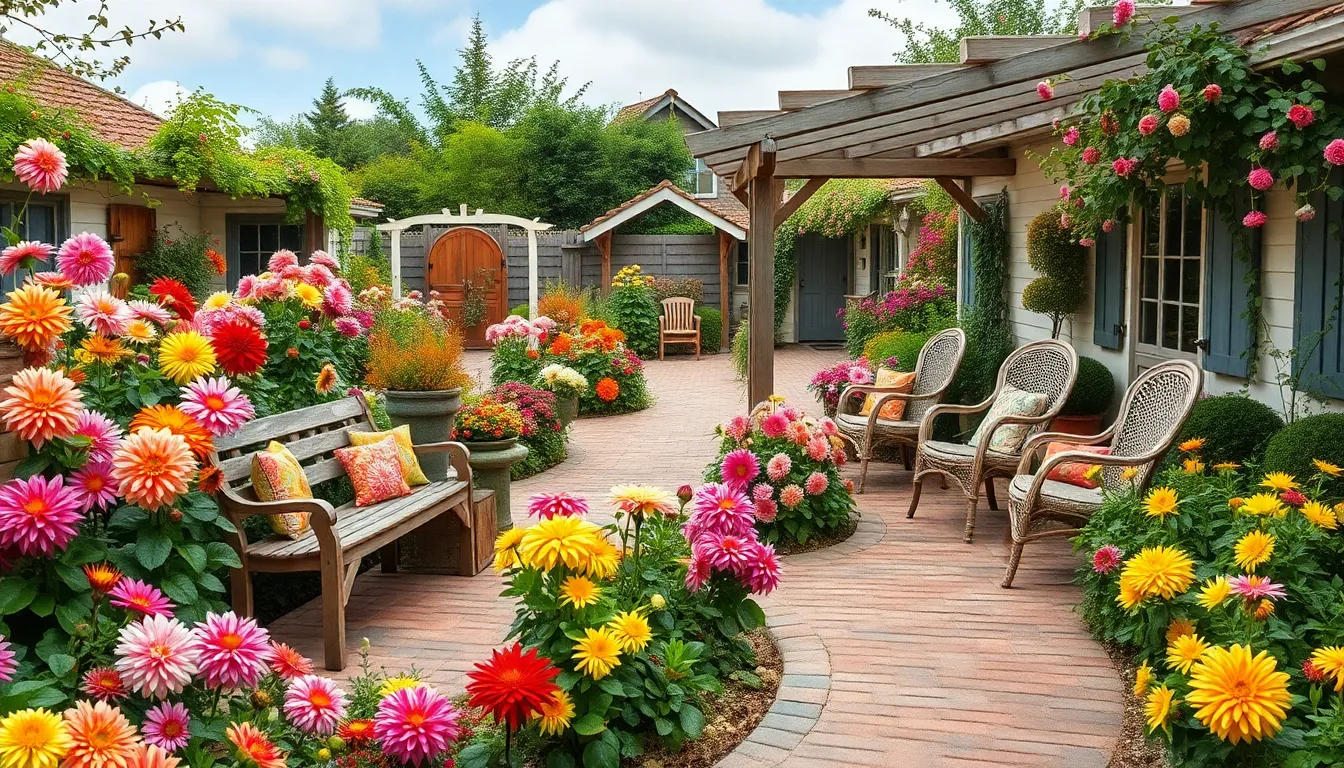
Creating a cottage-style dahlia garden brings together the best of both worlds: dahlia’s dramatic blooms and the relaxed charm of traditional English gardens.
Mix Dahlia Types for Textural Interest
Combining different dahlia varieties creates the layered, abundant look that defines cottage garden style. We recommend incorporating pom-pom dahlias with their perfectly rounded blooms alongside spiky cactus dahlias for striking contrast. Ball dahlias add classical elegance with their formal spherical shapes, while decorative varieties contribute broad, flat-petaled flowers that fill gaps beautifully.
Selecting a thoughtful color palette enhances your cottage garden’s natural appeal. Pastel dahlias in soft pinks, lavenders, and creamy whites create a romantic foundation, while vibrant oranges, deep purples, and bright yellows add energetic bursts throughout the space. This combination ensures your garden maintains visual interest from early summer through the first frost.
Add Informal Pathways and Seating Areas
Meandering pathways using natural stone or aged brick encourage visitors to wander and discover hidden garden corners. We suggest creating gently curved paths that wind between dahlia plantings rather than straight lines, which feel too formal for cottage garden style. These materials develop beautiful patina over time, adding to your garden’s established character.
Incorporating cozy seating areas transforms your dahlia garden into an outdoor living space. Weathered wooden benches positioned near fragrant plantings invite morning coffee breaks, while wicker chairs create intimate conversation nooks. We place these seating areas where visitors can fully appreciate dahlia blooms at eye level and enjoy the garden’s seasonal changes.
Integrate Climbing Plants and Arbors
Adding vertical elements through climbing plants creates the layered structure essential to cottage gardens. Roses climbing over arbors provide romantic backdrops for dahlia displays, while clematis vines offer delicate flowers that complement dahlia’s bolder blooms. Wisteria adds dramatic seasonal impact with its cascading purple or white flower clusters.
Installing arbors and trellises provides necessary support while creating garden rooms and shaded retreats. We position these structures to frame pathways and create natural transitions between different garden areas. Wooden arbors develop weathered character that perfectly suits cottage garden aesthetics, while providing practical support for climbing plants that enhance your dahlia displays with vertical interest.
Build a Modern Minimalist Dahlia Display
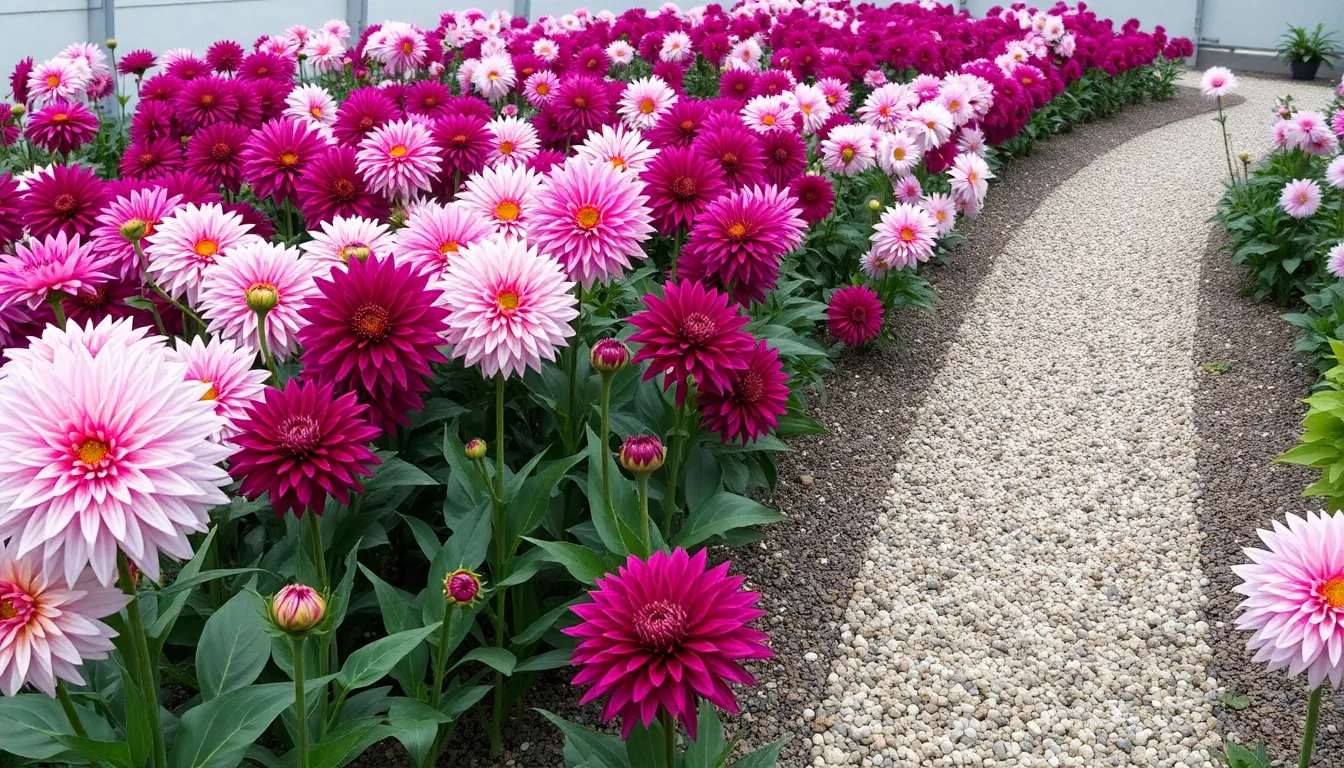
Creating a modern minimalist dahlia display offers a refreshing contrast to the abundant cottage style approach. We’ll focus on clean lines and sophisticated simplicity to showcase dahlia beauty.
Select Monochromatic Color Schemes
Monochromatic color schemes form the foundation of minimalist dahlia gardens. We recommend choosing dahlias within a single hue family, such as various shades of pink ranging from pale blush to deep magenta, to create visual cohesion without overwhelming complexity.
Single hue varieties work exceptionally well when we select different tones of the same color. Purple dahlias offer stunning options from lavender to deep plum, while white varieties provide crisp elegance with cream and pure white blooms.
Impactful contrast emerges when we pair light and dark shades within our chosen color family. Light pink dahlias paired with burgundy varieties create depth while maintaining the monochromatic principle that defines minimalist design.
Use Geometric Planting Patterns
Geometric planting patterns emphasize the structured nature of modern minimalist gardens. We achieve clean aesthetics by arranging dahlias in precise shapes rather than organic, flowing designs.
Structured layouts work best when we plant dahlias in circles, squares, or rectangular grids. These geometric shapes create visual order and highlight each dahlia’s individual beauty while contributing to the overall design harmony.
Symmetry and balance become essential elements as we plan our dahlia placement. Mirrored arrangements on either side of pathways or central focal points establish the sense of order that minimalist gardens require.
Incorporate Clean Hardscaping Elements
Clean hardscaping elements provide the structural backbone that modern minimalist dahlia displays need. We integrate materials and containers that complement rather than compete with our dahlia selections.
Simple pathways enhance accessibility while maintaining aesthetic integrity. Gravel or concrete pathways offer clean lines that guide visitors through our dahlia display without creating visual clutter or distraction from the blooms.
Minimalist containers work perfectly for compact varieties like Dahlietta Patty, which thrive in small spaces and geometric planters. Simple rectangular or cylindrical containers in neutral colors allow the dahlias to take center stage while adding architectural interest to our design.
Regular maintenance keeps our minimalist display looking pristine throughout the growing season. Deadheading spent blooms encourages continuous flowering while maintaining the clean appearance that defines this garden style.
Establish a Cut Flower Dahlia Garden
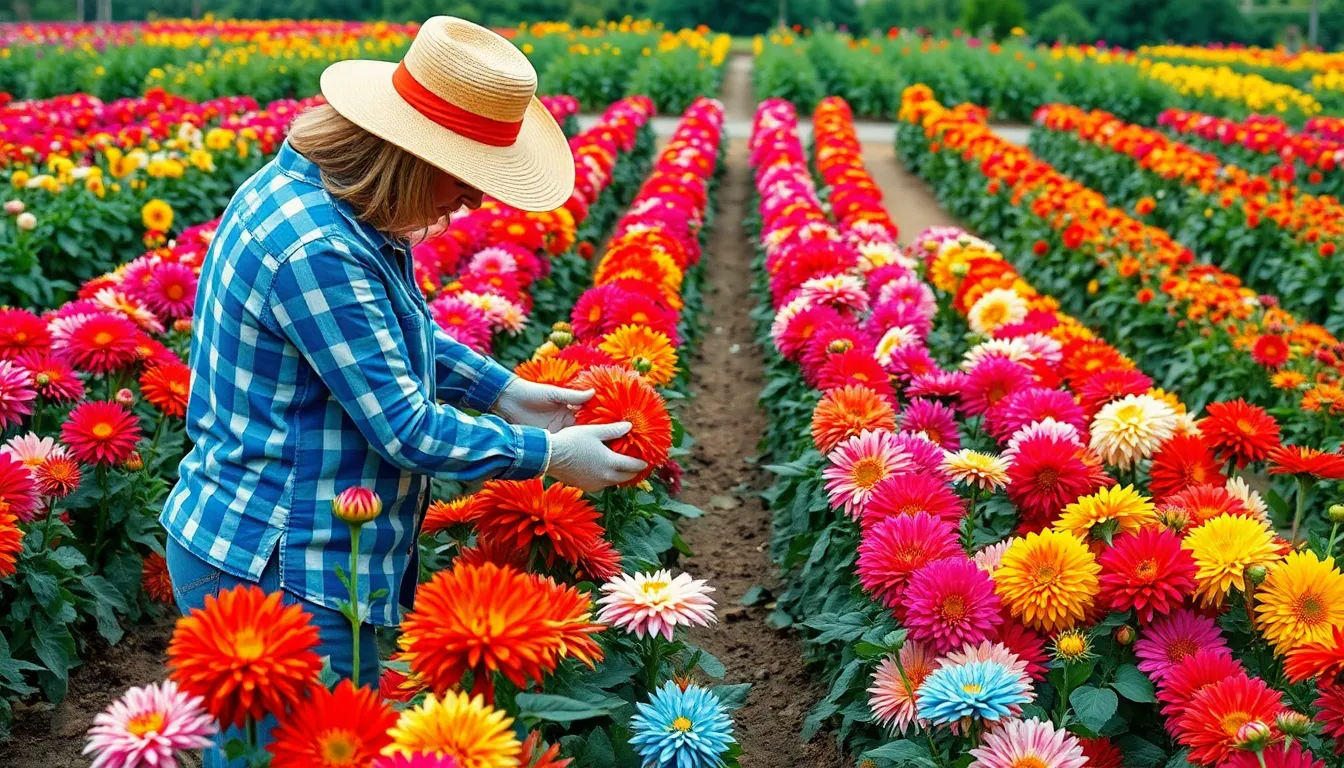
Transitioning from ornamental displays to functional beauty, we can create a dahlia garden specifically designed for harvesting cut flowers. Building a dedicated cutting garden allows us to enjoy fresh dahlia blooms indoors while maintaining an organized outdoor space.
Organize by Bloom Size and Stem Length
Arranging dahlias by their bloom size and stem length creates both visual appeal and practical harvesting efficiency. We’ll position shorter varieties like ‘Crichton Honey’ (2-4 ft) near the front of our cutting garden where they’re easily accessible. Taller varieties such as ‘Diva’ work best towards the back where their impressive height won’t overshadow smaller blooms.
Strategic placement based on stem length ensures we can harvest efficiently without disturbing other plants. Varieties with longer stems provide better vase life and arrangement flexibility. Medium-height dahlias fill the middle ground perfectly, creating a tiered effect that maximizes both garden beauty and cutting potential.
Create Dedicated Harvesting Rows
Designing rows with adequate spacing transforms our cutting garden into an efficient harvesting system. We’ll allocate approximately 3 feet of space for each dahlia plant if we’re not planning to dig and divide them annually. This generous spacing allows comfortable access for maintenance tasks and harvesting activities.
Straight row configurations work best for cutting gardens since they help easy movement between plants. We can create pathways wide enough for garden carts or wheelbarrows to transport tools and harvested flowers. Regular spacing between rows prevents overcrowding and ensures each plant receives adequate sunlight and air circulation.
Install Efficient Irrigation Systems
Implementing a drip irrigation system conserves water while reducing fungal diseases that thrive in moist conditions. This targeted watering method delivers moisture directly to dahlia roots, minimizing evaporation and runoff that occurs with overhead sprinklers. We’ll position drip lines close to plant bases to ensure efficient water uptake.
Automated irrigation systems save time and provide consistent moisture levels throughout the growing season. Timer-controlled systems allow us to water during optimal morning hours when evaporation rates are lowest. Consistent soil moisture promotes steady bloom production and healthier stems for cutting purposes.
Develop a Container Dahlia Garden

Container gardening offers incredible flexibility for dahlia enthusiasts who want to enjoy these stunning blooms in any space. We can create beautiful dahlia displays on patios, decks, or balconies while maintaining complete control over growing conditions.
Choose Appropriate Pot Sizes and Materials
Selecting pots that measure at least 12 to 18 inches in diameter and depth ensures our dahlia tubers have adequate room for healthy root development. Larger containers provide better stability and moisture retention, which helps prevent stress during hot summer days.
Drainage becomes critical when we choose materials for our dahlia containers. Pots with ample drainage holes prevent waterlogging that can quickly rot delicate tubers. Self-watering containers like Aquapots maintain consistent moisture levels while eliminating the guesswork from daily watering schedules.
Materials matter significantly when we consider long-term durability and plant health. Ceramic, fiberglass, and high-quality plastic containers all work well, though we should avoid materials that heat up excessively in direct sunlight.
Plan for Mobility and Seasonal Changes
Lightweight yet sturdy containers give us the flexibility to move our dahlia displays as needed throughout the growing season. We can chase optimal sunlight conditions or protect plants from severe weather without damaging root systems.
Weight distribution requires careful consideration to prevent containers from toppling during strong winds. Heavier pots provide stability, but we can achieve balance by using lighter materials filled with quality potting mix rather than garden soil.
Seasonal planning becomes essential since dahlia tubers need protection from freezing temperatures. We lift tubers in winter and store them in frost-free areas, making container growing ideal for regions with harsh winters.
Mobility advantages extend beyond weather protection to include design flexibility. We can rearrange our dahlia containers to create new focal points or accommodate seasonal garden changes.
Combine with Complementary Container Plants
Height contrast creates visual drama when we incorporate taller plants like Cleome Violet Queen, Buddleias Purple, or Verbena bonariensis alongside our dahlias. These vertical accents add structure while allowing dahlia blooms to remain the primary attraction.
Low-growing companions such as variegated vinca vine, sweet alyssum, or creeping Jenny provide textural diversity at container bases. These trailing plants soften container edges while creating layered displays that feel professionally designed.
Sunlight requirements must align across all container plants to ensure healthy growth patterns. We position our containers to receive at least 6 hours of full sun daily and rotate them periodically for even light exposure.
Regular fertilization becomes more critical in container environments where nutrients deplete faster than in garden beds. We feed our dahlia containers consistently to promote vigorous growth and abundant blooming throughout the season.
Plant a Dahlia Meadow Garden
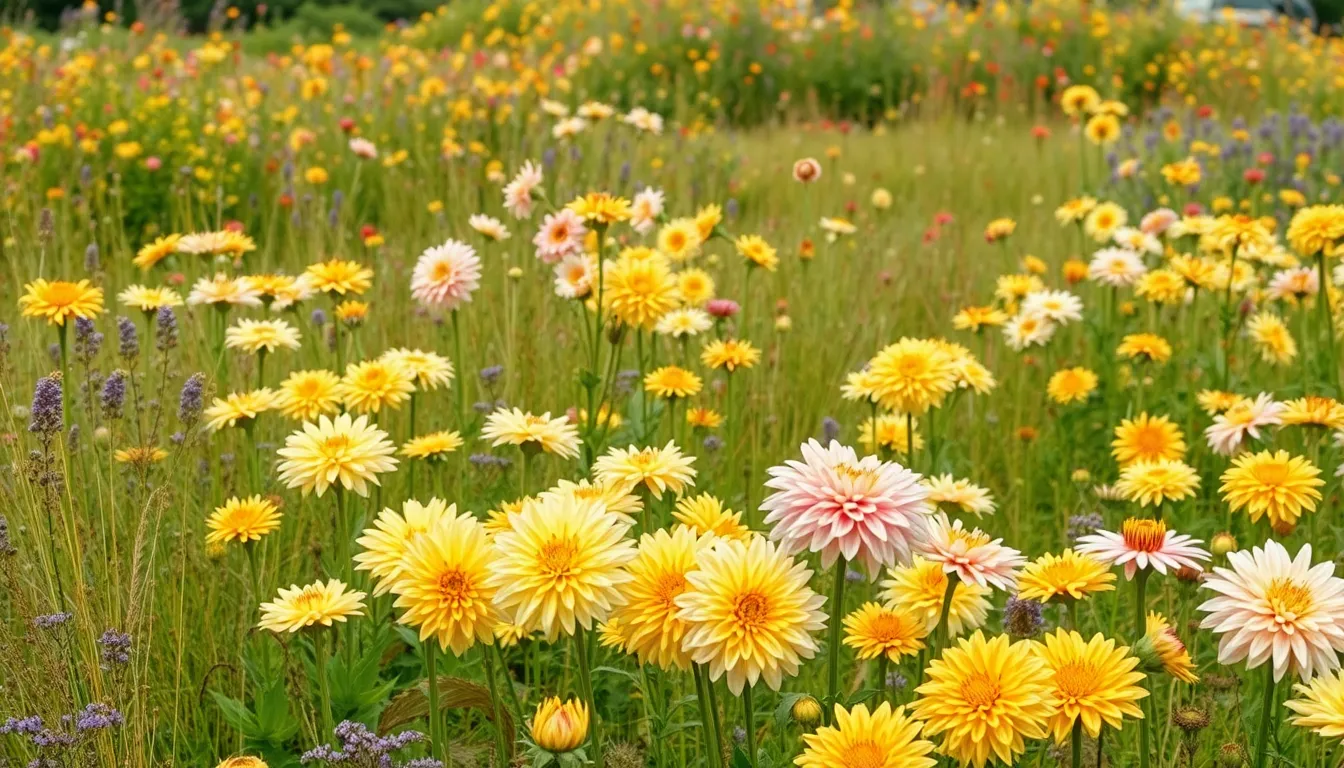
Creating a dahlia meadow garden offers a refreshing departure from formal garden designs, combining the stunning blooms of dahlias with the wild, natural beauty of a meadow industry. This approach transforms your space into a ever-changing, pollinator-friendly haven that supports local ecosystems while showcasing dahlia varieties in their most natural setting.
Select Naturalistic Dahlia Varieties
Choose dahlia varieties with simple, daisy-like forms rather than heavily ruffled or geometric types to achieve an authentic meadow aesthetic. Single-flowered dahlias like ‘Bishop of Llandaff’ and ‘Mystic Illusion’ provide the uncomplicated beauty that mimics wildflowers in natural settings.
Focus on muted or harmonious color tones instead of overly bright or contrasting hues that might disrupt the meadow’s gentle flow. Soft yellows, pale pinks, cream whites, and dusty purples create a cohesive palette that blends seamlessly with native wildflowers and grasses.
Select compact to medium-height varieties that won’t overpower the delicate balance of a meadow garden. Dahlias ranging from 2 to 4 feet tall integrate beautifully with native plants without creating jarring height differences that break the natural rhythm.
Prioritize varieties with open centers that provide easy access for pollinators like bees and butterflies. These simple flower forms offer the nectar and pollen sources that support biodiversity while maintaining the meadow’s ecological function.
Integrate Native Grasses and Wildflowers
Plant native grasses like Calamagrostis and Panicum around your dahlias to create structural backbone and natural texture throughout the growing season. These grasses provide year-round interest and movement while complementing dahlia blooms during peak season.
Add wildflowers such as coneflowers, black-eyed Susans, and asters that share similar growth habits with dahlias and bloom in complementary seasons. This combination ensures continuous color and interest from early summer through fall while supporting local pollinators.
Space plantings to allow natural intermingling between dahlias and native species, creating the spontaneous appearance of a wild meadow. Leave gaps between plants for self-seeding annuals and volunteer wildflowers to establish naturally over time.
Choose plants with overlapping bloom periods to maintain visual interest throughout the growing season. Early-blooming wildflowers bridge the gap before dahlias reach peak performance, while late-season asters extend color into autumn.
Design Flowing, Organic Shapes
Create drifts and clusters of plants rather than rigid rows or geometric patterns to mimic natural plant communities found in wild meadows. Group odd numbers of the same variety together for visual impact while maintaining an organic appearance.
Use gentle, undulating lines instead of straight borders to guide the eye through the garden naturally. These flowing curves create visual movement and harmony while allowing lower-growing grasses and wildflowers to weave throughout the design.
Place taller plants toward the center or back of beds while allowing shorter species to flow forward in irregular patterns. This layered approach creates depth and prevents any single element from dominating the meadow’s balanced composition.
Allow paths to curve naturally through the garden space, following the contours of plant groupings rather than cutting straight lines through the design. These organic pathways invite exploration while maintaining the meadow’s wild, unstructured character.
Construct a Dahlia Trial Garden
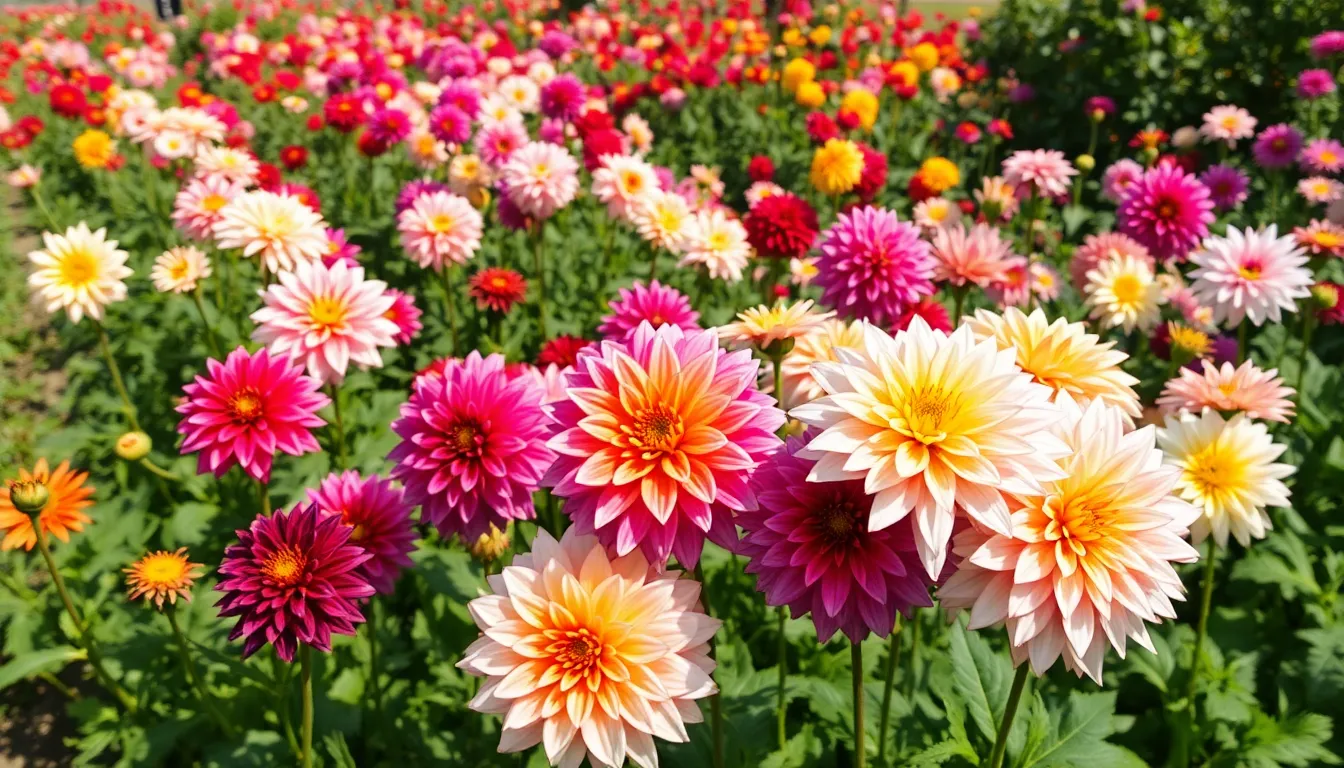
Building on our exploration of various dahlia garden styles, we can create a trial garden that serves as both a testing ground and showcase for different dahlia varieties. This approach allows us to evaluate performance while contributing valuable data to the gardening community.
Experiment with New and Rare Varieties
Researching unique dahlia varieties through online catalogs and specialty nurseries opens doors to extraordinary specimens that transform our gardens into distinctive displays. We’ll discover varieties with unusual color combinations, flower forms, and growth habits that aren’t available in typical garden centers. Testing these varieties under different growing conditions helps us understand their adaptability to our local climate, soil type, and seasonal weather patterns.
Varied planting locations within our trial garden create natural experiments that reveal which varieties thrive in morning sun versus full sun exposure. We can evaluate drought tolerance by placing some specimens in areas with less irrigation while monitoring their performance compared to well-watered counterparts. Recording bloom timing, disease resistance, and overall vigor provides valuable insights that benefit future planting decisions.
Document Growth Patterns and Preferences
Keeping a detailed garden journal captures essential data about each variety’s performance throughout the growing season. We’ll record germination rates, first bloom dates, peak flowering periods, and final frost survival to create comprehensive profiles for each dahlia type. Notes about growth habits, such as branching patterns and stem strength, help us plan future garden layouts and support requirements.
Photography serves as our visual documentation system, capturing weekly progress shots that reveal subtle changes often missed during daily observations. We can photograph individual blooms to document color variations, size measurements, and form characteristics that change throughout the season. Monthly overview shots of the entire trial garden create a timeline that showcases seasonal progression and variety interactions.
Weather correlation tracking connects our observations to exact environmental conditions, helping us identify which varieties perform best during heat waves, rainy periods, or temperature fluctuations. Recording soil moisture levels, fertilization schedules, and pest encounters creates a complete picture of growing conditions that influenced each variety’s success.
Share Results with Local Gardening Communities
Joining local gardening groups and online dahlia forums creates opportunities to share our trial garden findings with fellow enthusiasts who benefit from real industry growing experiences. We can contribute variety reviews, growth comparisons, and climate adaptation insights that help other gardeners make informed planting choices. Participating in regional dahlia society meetings allows us to exchange tubers and compare results with gardeners facing similar growing challenges.
Hosting garden tours during peak bloom periods showcases our trial garden while educating visitors about different dahlia varieties and their characteristics. We’ll prepare plant labels with variety names, bloom classifications, and our performance notes to create an educational experience that benefits the broader gardening community. Workshop presentations featuring our documented results provide valuable data that supports local garden planning and variety selection.
Online sharing through gardening blogs, social media groups, and dahlia databases extends our impact beyond local communities to reach gardeners worldwide. We can upload performance data, photographs, and growing tips that contribute to the collective knowledge base about dahlia cultivation in various climates and conditions.
Conclusion
Creating your perfect dahlia garden doesn’t have to be overwhelming. Whether you’re drawn to the structured elegance of a modern minimalist display or the wild beauty of a naturalistic meadow garden each approach offers its own rewards.
We’ve explored how dahlias can transform any space from traditional borders to innovative container gardens. The key lies in choosing the right style that matches your vision and maintenance preferences.
Remember that successful dahlia gardening comes down to understanding your space your climate and your goals. Start with one approach that speaks to you then expand as your confidence grows.
Your dahlia garden will become a source of joy and inspiration bringing months of spectacular blooms to your outdoor space. The investment in planning and preparation will pay dividends in years of stunning displays.
Frequently Asked Questions
What are the best dahlia varieties for beginners?
For novice gardeners, compact dahlia varieties like pompons and ball dahlias are ideal starting points. These varieties are easier to maintain, require less staking, and offer reliable blooms throughout the season. Choose early-blooming varieties that establish quickly and provide consistent color from summer through fall.
How do I create height variation in my dahlia border garden?
Plan your dahlia border using a three-tier approach: place tall dahlia varieties (4-6 feet) in the back as dramatic backdrops, medium-height varieties (2-3 feet) in the middle ground, and compact dahlias (1-2 feet) in the front. This creates visual depth and ensures all plants receive adequate sunlight.
What colors work best for a cottage-style dahlia garden?
Cottage-style dahlia gardens thrive with a mix of soft pastels and vibrant hues. Combine blush pinks, creamy whites, and lavender dahlias with bold reds, oranges, and deep purples. This balanced color palette creates the relaxed, romantic charm characteristic of traditional English cottage gardens while maintaining visual interest.
How do I design a modern minimalist dahlia display?
Focus on monochromatic color schemes using dahlias within a single hue family for visual cohesion. Plant in geometric patterns with clean lines, incorporate simple hardscaping elements like straight pathways, and use minimalist containers. Regular maintenance and deadheading are crucial to maintain the clean, structured appearance.
What’s the difference between a cut flower dahlia garden and a regular dahlia garden?
Cut flower dahlia gardens are specifically organized for harvesting efficiency. Dahlias are arranged by bloom size and stem length in dedicated rows, making cutting easier. These gardens also feature efficient irrigation systems and focus on varieties that produce long, sturdy stems ideal for bouquets and arrangements.
Can I grow dahlias successfully in containers?
Yes, container dahlia gardens offer excellent flexibility for various spaces. Choose pots at least 12-18 inches wide with good drainage, select compact or medium-sized dahlia varieties, and ensure containers are mobile for optimal sunlight positioning. Combine dahlias with complementary plants for enhanced visual appeal.
What makes a dahlia meadow garden different from other dahlia garden styles?
Dahlia meadow gardens emphasize naturalistic planting by integrating dahlia varieties with native grasses and wildflowers. This approach creates a more casual, ecosystem-friendly environment that supports local wildlife while maintaining the beauty of dahlia blooms in a less formal, more organic setting.
How do I start a dahlia trial garden?
Begin by dedicating a section of your garden to testing new and rare dahlia varieties. Keep detailed records of growth patterns, bloom performance, and seasonal changes through a garden journal and photography. Share your findings with local gardening communities and online platforms to contribute to collective dahlia knowledge.









